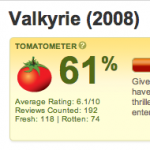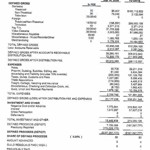 Below are the financial projections made by 20th Century Fox in the run up to the production of Valkyrie, showing how they work out how much is Tom Cruise paid. These numbers come from an internal file created to project the film’s costs and possible returns. The film was made by MGM but Fox were handling the international distribution.
Below are the financial projections made by 20th Century Fox in the run up to the production of Valkyrie, showing how they work out how much is Tom Cruise paid. These numbers come from an internal file created to project the film’s costs and possible returns. The film was made by MGM but Fox were handling the international distribution.
I’ve had these figures for a while and have been using them in classrooms of filmmakers and new producers. It’s always been one of the more fun lectures to teach, partly because of the opaque nature of Hollywood Accounting and partly to see the students’ reaction to the figures involved. I’ve long held the belief that we in the industry have a duty to teach the next generation what they need to know. Film producing can mean playing a high stakes game and it hardly seems fair that producers need to learn some aspects ‘on the job’ when a little bit of openness would help immensely.
I have spent some time to explain what these numbers mean, and my full explanations and notes are later in the article. I have also created a Terminology Guide at the bottom of the article to demystify some of the language used.
In summary:
- Tom Cruise received 10% of the revenue
- Which Fox predicted being between $38 million and $72 million
- Fox receives 49% of the published box office figures
- Fox charge an Overhead cost of 7.5 percent
- A ‘five-star’ Valkyrie means $277m more revenue than ‘one-star’
- Television income is largely immune to the film’s quality
- The film needed revenue of $425 million to “break-even”
- And that “break-even” would have netted Tom Cruise $47 million
Income at a glance
The chart below shows where the film’s revenue was expected to come from in the event the film reached “breakeven”. This is a total income of $451 million, 55% of which comes from North America and 45% from the rest of the world.
Costs at a glance
The chart below shows where the $451 million of revenue was spent, and which meant that film broke even.
Tom Cruise received 10 percent of revenue
 Tom Cruise’s pay check is calculated thusly:
Tom Cruise’s pay check is calculated thusly:
- Tom Cruise received an $15 million advance, against the money below
- 5.25% of DVD revenues (i.e. 15% of 35% of worldwide Home Video)
- 15% of the revenue from all other sources (i.e. Theatrical, Non-Theatrical, Pay TV, PPV, VOD, Cable, Network and Syndication)
Note that these are revenue calculations, not profit. “Profit” is an unpopular word in the film business, after years of Hollywood Accounting has made the term almost meaningless. A smart industry player like Mr Cruise knows to demand a share of revenue rather than profits.
The lowest Fox believed this realistically could be was $38 million and the most $72 million.
Bryan Singer got a third less than Tom Cruise
 Bryan Singer‘s deal is described calculated in two parts. Firstly, for his role as director:
Bryan Singer‘s deal is described calculated in two parts. Firstly, for his role as director:
- $10m up front against
- 5% Gross Proceeds from first dollar – 15% Distrib. Fee, DVD @ 20% Royalty base
- 8% Gross Proceeds in excess B/E – 15% Distrib. Fee, DVD @ 20% Royalty base
- $500k Bonus @ B/E
And the second part is for his producing activities:
- $1.5m up front against
- 5% Gross Proceeds from first dollar – 15% Distrib. Fee, DVD @ 20% Royalty base
- 8% Gross Proceeds in excess B/E – 15% Distrib. Fee, DVD @ 20% Royalty base
 Writer / producer Christopher McQuarrie received:
Writer / producer Christopher McQuarrie received:
- $1.5m up front against
- 4% Gross Proceeds from first dollar – 15% Distrib. Fee, DVD @ 20% Royalty base
- 6% Gross Proceeds in excess B/E – 15% Distrib. Fee, DVD @ 20% Royalty base
Note that although they are receiving “gross proceeds”, like Mr Cruise, they have agreed that Fox can deduct a 15% distribution fee before it’s calculated. Tom Cruise’s distribution fee is listed as “0%”. Smart cookie.
Fox receives 49 percent of the Box Office
The expected revenue from the Domestic and International Theatrical releases are a fixed percentage of the box office receipts. Domestically, Fox receives 49% of the box office, with the other 51% staying with the cinemas. Internationally the figure is slightly lower at 45%, presumably to reflect the additional costs of doing business outside their home territory.
This is an important figure as it is one of the (many) reasons why headlines such a “$100m movie breaks-even by crossing $100m at box office” are plain wrong. Other factors which make that assumption pointless are…
- The deduction of sales tax from the BO figure, which in the UK is 20%
- The additional revenue from DVD, VOD, TV, games, merchandise, music, etc, etc
- The additional costs of marketing, distribution, star fees, etc
- The unreliability of the published budget. Some are inflated to increase public appetite while others are suppressed to save embarrassed Execs.
‘5-star’ reviews mean $277m more than ‘1-stars’
 The difference between their ‘best case’ and ‘worse case’ revenue guesses is over $277million. If we assume that the film’s performance is mostly down to its quality (as judged by popular appeal) then this is a huge amount of money to be wagered on the skills of the creatives behind the film. It’s often said that Hollywood doesn’t care about the quality of the films they produce but with Valkyrie we can see that it has a major impact on something they certainly do care about – their bottom line.
The difference between their ‘best case’ and ‘worse case’ revenue guesses is over $277million. If we assume that the film’s performance is mostly down to its quality (as judged by popular appeal) then this is a huge amount of money to be wagered on the skills of the creatives behind the film. It’s often said that Hollywood doesn’t care about the quality of the films they produce but with Valkyrie we can see that it has a major impact on something they certainly do care about – their bottom line.
TV income is largely immune to the film’s quality
Most of the revenue listed to come from television does not change between the ‘best’ and ‘worse’ cases. This is due to the television rights being agreed before the film has been finished. The one exception to this is the Domestic Pay TV which rises from $18.5m to $20m as the film fares better at the box office. This could be down to a success clause in the deal or a $20m celling on an agreed 18.5% of box office receipts.
In Hollywood, no-one knows anything
 This might seem like an obvious point but consider how much information other industries have about the likely success of their products before they have to commit to approaching the mass market. In most cases they will have been road-tested on small markets, rolled out slowly and evolved along the way. By the time they are considering if they should commit the big bucks to a national or international push they can be fairly confident of its success. Hollywood doesn’t have such a luxury. Each feature film is its own prototype and so much of the project’s success will depend of factors not apparent when the project is approved.
This might seem like an obvious point but consider how much information other industries have about the likely success of their products before they have to commit to approaching the mass market. In most cases they will have been road-tested on small markets, rolled out slowly and evolved along the way. By the time they are considering if they should commit the big bucks to a national or international push they can be fairly confident of its success. Hollywood doesn’t have such a luxury. Each feature film is its own prototype and so much of the project’s success will depend of factors not apparent when the project is approved.
It can be only a matter of weeks before the film’s release date that the studio have an idea of how it might perform. And it’s really only after the opening weekend that they know if they’ve made Batman or Pluto Nash.
Interestingly, in recent months Hollywood has got a new tool which can predict box office success with a 90% accuracy – Google. That said, it still only works soon before the release, rather than at script stage.
Notes on How is Tom Cruise paid?
Below are a few notes and observations to help anyone interested in the topic to better understand it.
This is just one example of a Hollywood film
These figures and calculations were created specifically for Valkyrie script, cast and crew. Fox will also have taken into consideration the market conditions at the time and the appeal for a WW2 Nazi thriller with Tom Cruise. Consequently it is hard to be sure which figures are universal to all Hollywood films and which are unique to this one. Factors like Tom Cruise’s star power will increase the film’s financial clout whereas the film’s themes are less commercial than average Hollywood fare.
Hollywood is making different types of movies
 Films of this scale are under threat as Hollywood focuses on smaller, niche genre films (such as Paranormal Activity, The Hangover) and huge “tentpole” blockbusters (such as The Avengers, Batman and Superman). There are increasing voices in the industry, including from Steven Spielberg, who say that such as policy will lead to an industry-wide crash if a series of tentpole movies fail in a row. In other news, a series of tentpole movies have failed in a row.
Films of this scale are under threat as Hollywood focuses on smaller, niche genre films (such as Paranormal Activity, The Hangover) and huge “tentpole” blockbusters (such as The Avengers, Batman and Superman). There are increasing voices in the industry, including from Steven Spielberg, who say that such as policy will lead to an industry-wide crash if a series of tentpole movies fail in a row. In other news, a series of tentpole movies have failed in a row.
Changing DVD revenues
Much has changed in the last five years, meaning that if this film were to be green lit today it could expect a different revenue model. VOD is likely to be much higher but DVD revenues would be suppressed. Piracy has had a huge effect on the revenue Hollywood receives from DVD and it’s likely that this would mean a 2013 version of Valkyrie would make less money that than the 2008 version.
In defence of the Hollywood Accountants
 Some people may use these numbers to accuse Fox of underhand accounting, pointing to the tiny ‘profit’ made on such a big turnover and to the fees charged, such as overhead and distribution fees. However, I would imagine that any major player in the financing of this film would have been aware of how Hollywood structures its deals and therefore would have entered into negotiations with their eyes open.
Some people may use these numbers to accuse Fox of underhand accounting, pointing to the tiny ‘profit’ made on such a big turnover and to the fees charged, such as overhead and distribution fees. However, I would imagine that any major player in the financing of this film would have been aware of how Hollywood structures its deals and therefore would have entered into negotiations with their eyes open.
Certainly it’s clear that Tom Cruise’s people knew what they were doing when they struck his deal. I’m not saying that the way the deals are structured is morally right, just that Fox shouldn’t be accused of anything illegal. Well, from these numbers, anyway.
In defence of Tom Cruise
 It’s true that Tom Cruise earned a massive amount of money from working on this film and it’s also true that most of the rest of the hard working cast and crew were not paid nearly so well. However, I feel I should stick up for Mr Cruise, albeit briefly. His name and star power can reasonably be assumed to be the main reason (a) that this film got made and (b) that millions of people paid to see it. The Studios are aware of his power, else they wouldn’t keep hiring him to lead their movies.
It’s true that Tom Cruise earned a massive amount of money from working on this film and it’s also true that most of the rest of the hard working cast and crew were not paid nearly so well. However, I feel I should stick up for Mr Cruise, albeit briefly. His name and star power can reasonably be assumed to be the main reason (a) that this film got made and (b) that millions of people paid to see it. The Studios are aware of his power, else they wouldn’t keep hiring him to lead their movies.
On this particular film, had Tom Cruise been paid half as much then I doubt that the rest of the cast and crew would have received anything extra. They would have been working on union rates, unconnected to the amount the star is paid or to the profitability of the film. Any monies not paid to Tom Cruise would go to 20th Century Fox and Rupert Murdoch. However, I accept that in the long-term the large amounts paid to both the Studios and to movie stars do have an effect when the unions try to renegotiate their agreements with the Studios.
Terminology Guide
- Domestic – America and Canada (“North America”)
- International – Everywhere else in the world
- Negative Cost – The film’s budget. (The name relates to the cost of creating the first film negative). In this case it excludes the Above The Line, which is to say the key talent, such as producer, director and main star.
- B/E – Breakeven. Due to Hollywood’s loose relationship with the word ‘profit’ I imagine that ‘breakeven’ was tightly defined within the contract’s small print.
- Home Video – This used to be VHS but now covers DVD. Hollywood isn’t quick to change its terminology!
- Non-theatrical – Screenings that aren’t part of the main cinematic release, such as festivals, colleges, museums and film societies
- Pay TV – Subscription-based television channels (HBO in the States, Sky Movies in the UK, etc)
- Syndication – At the end of a film’s release schedule, typically a deal will be done to screen the film multiple times over a number of years.
- PPV – Pay Per View. Slightly outdated idea of channels with movies starting at set times for which you pay a fee to be decrypted. An early form of VOD that baffles all the young film students I talk to.
- VOD – Video On Demand. Including both subscription based (Netflix, LoveFilm) and transactional (iTunes, BlinkBox).
- Hollywood Accounting – A variety of shady practices carried out by the Studios to maximise their share of a film’s revenue. If they can ‘prove’ a loss they don’t have to pay anyone who is owed a share of the profits.





Comments
Interesting article, but surely the film under-performed on the projections and the result is to the left of the “low” column? Boxofficemojo has the WW gross at $200m http://www.boxofficemojo.com/movies/?id=valkyrie.htm, but the “low” in the spreadsheet is $270m
True, the film did under perform based on this model.
The release date was moved around quite a bit before the film was actually released, so it’s possible that this model was based on a better release slot. This might have meant a revised revenue model, although if course they would have had to kept to contractual contingent compensation agreements to the principle players.
It’s always really hard to know the complete truth with Hollywood as so much is kept under wraps.
Also it could have done better than expected on DVD and overall been in line with the projections, ie those that were expected to have gone to cinema just watched at home, and the margin on DVD may be better for Fox (and Tom…)
Domestic DVD was $27m…so it seems like the film made a substantial “loss”. That said some “costs” are revenue streams for Fox ie overheads, distribution fees (appx $50m in the lowest column). It clearly did not perform as hoped which shows how the Studios need the hits to even out the duds.
The film flopped, fox must have taken a major writeoff.
How much is paid to tom cruise for each movie he makes and does he get a box office percentage?